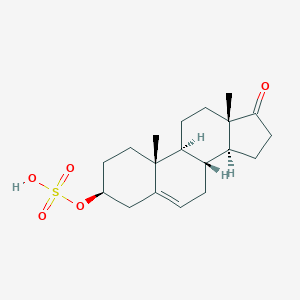| Full List of Protein(s) Regulating This Metabolite |
| Apolipoprotein (Apo) |
|---|
| Apolipoprotein A-II (APOA2) |
Click to Show/Hide the Full List of Regulating Pair(s): 1 Pair(s)
|
| Detailed Information |
Protein Info
 click to show the details of this protein click to show the details of this protein
|
| Regulating Pair |
Experim Info
 click to show the details of experiment for validating this pair click to show the details of experiment for validating this pair
|
[2] |
| Introduced Variation |
Mutation (-265T >C(rs5082)) of APOA2 |
| Induced Change |
Dehydroepiandrosterone sulfate concentration: increase (FC = 1.57) |
| Summary |
Introduced Variation

 Induced Change
Induced Change

|
| Disease Status |
Obesity [ICD-11: 5B81]
|
| Details |
It is reported that mutation (-265T >C(rs5082)) of APOA2 leads to the increase of dehydroepiandrosterone sulfate levels compared with control group. |
| ATP-binding cassette transporter (ABCT) |
|---|
| Multidrug resistance-associated 8 (MRP8) |
Click to Show/Hide the Full List of Regulating Pair(s): 2 Pair(s)
|
| Detailed Information |
Protein Info
 click to show the details of this protein click to show the details of this protein
|
| Regulating Pair (1) |
Experim Info
 click to show the details of experiment for validating this pair click to show the details of experiment for validating this pair
|
[3] |
| Introduced Variation |
Mutation (T546M) of ABCC11 |
| Induced Change |
Dehydroepiandrosterone sulfate concentration: decrease |
| Summary |
Introduced Variation

 Induced Change
Induced Change

|
| Disease Status |
Healthy individual
|
| Details |
It is reported that mutation (T546M) of ABCC11 leads to the decrease of dehydroepiandrosterone sulfate levels compared with control group. |
| Regulating Pair (2) |
Experim Info
 click to show the details of experiment for validating this pair click to show the details of experiment for validating this pair
|
[3] |
| Introduced Variation |
Overexpression of ABCC11 |
| Induced Change |
Dehydroepiandrosterone sulfate concentration: increase (FC = 3) |
| Summary |
Introduced Variation

 Induced Change
Induced Change

|
| Disease Status |
Healthy individual
|
| Details |
It is reported that overexpression of ABCC11 leads to the increase of dehydroepiandrosterone sulfate levels compared with control group. |
|
|
|
|
|
|
|
 click to show the details of this protein
click to show the details of this protein
 click to show the details of experiment for validating this pair
click to show the details of experiment for validating this pair
 click to show the details of this protein
click to show the details of this protein
 click to show the details of experiment for validating this pair
click to show the details of experiment for validating this pair
 click to show the details of this protein
click to show the details of this protein
 click to show the details of experiment for validating this pair
click to show the details of experiment for validating this pair
 click to show the details of experiment for validating this pair
click to show the details of experiment for validating this pair

